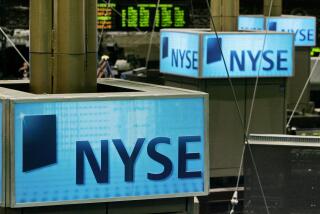Reading Telltale Signs of Looming Cuts in Dividends
These are tough times for individuals who rely on income from stock dividends. This group doesn’t include only the wealthy. It includes many retirees and others on fixed incomes.
In the past few months, a number of big companies--including Chrysler Corp., Security Pacific, Occidental Petroleum, McDonnell Douglas and CBS--have significantly pared their quarterly cash payments to shareholders.
During the first five months of 1991, 97 companies cut their dividends, and another 114 eliminated these payments altogether. The number of companies increasing their dividend payments has fallen 23% from a year ago.
If things continue at this pace, 1991 will prove to be the biggest year for dividend slashing since 1982.
Corporations that recently have cut dividends maintain that their shareholders are just suffering along with everyone else. Dividend payments are generally tied to company profitability, so it follows that dividends are going to slide, too.
But shareholders don’t need to sit idly by and just take their lumps. Dividend experts say individuals can limit their chances of suffering cuts by carefully monitoring their investments.
And there are telltale signs that indicate a cut is likely, said Geraldine Weiss of Investment Quality Trends, an investment advisory service.
The worst sign is when a company’s profit is insufficient to pay dividends without tapping other sources of funds, Weiss said. You should be able to figure this out by looking at the company’s annual financial statement.
There, the company should reveal the number of shares it has outstanding, its annual cash dividends and its net profit.
Multiply the total number of shares outstanding by the annual dividend to get the total payout. If the number you get is higher than the company’s net profit, a dividend cut is highly probable. Indeed, if the total payout amounts to more than 50%, it should be a warning sign, Weiss said.
But there are exceptions. If the company’s earnings were pared by one-time charges, the ratio is less of a worry. Also, certain types of firms, such as utilities, tend to pay out a greater proportion of their earnings.
Additionally, certain industries have been harder hit by the recession than others. Companies in financial services, real estate and automobiles are more likely to cut their dividends, if they haven’t already, than companies in relatively recession-proof industries such as health care and pharmaceuticals.
Another tip: The first few pages of most annual reports include a manager’s discussion of the company’s financial results. Often, if a dividend cut is in the offing, the company will allude to it in this statement, according to Weiss.
Lastly, if the dividend yield--the annual dividend divided by the market price of the stock--is unusually high, that should also serve as a warning.
It doesn’t necessarily portend a cut, but it indicates that other investors believe that something is wrong at that firm.
What’s an unusually high yield? It varies industry by industry, but generally speaking yields above 6% are lofty.
The exception, again, is utility stocks, which can yield 7% or 8%. Drug companies tend to be on the low end of the spectrum, usually offering 2% to 3% yields, Arnold Kaufman, editor of Standard & Poor’s Outlook, an investment newsletter, said.
But there is another way to go about dividend investing, Kaufman said.
Those who can live without current dividends might be wise to invest in companies that have recently slashed their payments to shareholders--provided, of course, that the company is still healthy.
Or they might consider young companies with bright prospects. Many of these firms don’t pay dividends now but are likely to in the future.
The success of this strategy hinges on being able to pick up shares at bargain-basement prices. If the company is strong and able to weather these tough times, it will probably start hiking or declaring dividends once the recession is over. And that could leave investors with gratifying returns in the long run.
EDITOR’S NOTE: Starting this week, Kathy M. Kristof’s Personal Finance column appears in the business section during the week as well as on Sundays.
More to Read
Inside the business of entertainment
The Wide Shot brings you news, analysis and insights on everything from streaming wars to production — and what it all means for the future.
You may occasionally receive promotional content from the Los Angeles Times.










